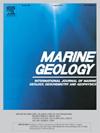Origin and critical metals enrichment of ferromanganese precipitates from Jiawang Seamount (Hook Ridge) Antarctica: Geochemistry and isotope evidence
IF 2.2
3区 地球科学
Q2 GEOSCIENCES, MULTIDISCIPLINARY
引用次数: 0
Abstract
Marine ferromanganese precipitates are globally recognized as significant minerals resources within the world's oceans. Our study presents an analysis of isotopic geochemistry of ferromanganese precipitates from the Jiawang Seamount in Antarctica, comparing them with typical low-temperature hydrothermal ferromanganese precipitates found in oceanic settings. We discuss the genesis of ferromanganese precipitates and the characteristics of critical metals' enrichment. The chemical compositions imply that the ferromanganese precipitates from Jiawang Seamount are of hydrothermal origin. However, the enrichment characteristics of critical metals such as Co, Ni, Cu, Zn, Mo, Pb, REE, aside from Fe and Mn, are not conspicuous and possess relatively inferior potential compared with typical hydrothermal ferromanganese precipitates in the oceans. These critical metals originate from hydrothermal fluid, and their enrichment is positively correlated with the precipitation process of Mn oxides. The Sr isotope results reveal that the formation of ferromanganese precipitates underwent at least two distinct periods of hydrothermal activity, respectively at 9.5 Ma and 15–16 Ma. The chemical composition and Nd - Pb isotopic characteristics of ferromanganese precipitates suggest that the hydrothermal fluid composition is substantially similar during different periods. The formation of ferromanganese precipitates from Jiawang Seamount is closely related to regional hydrothermal activities that accompany basin development. Based on the Sr isotope estimation of hydrothermal activity, the Bransfield Strait basin is at least older than 16 Ma.
南极贾汪海山(虎克海脊)铁锰沉淀物的起源和临界金属富集:地球化学和同位素证据
海洋锰铁沉淀物是全球公认的世界海洋重要矿物资源。我们的研究对南极洲贾汪海山锰铁沉淀物的同位素地球化学进行了分析,并将其与大洋环境中发现的典型低温热液锰铁沉淀物进行了比较。我们讨论了锰铁沉淀物的成因和临界金属富集的特征。化学成分表明,贾汪海山的锰铁沉淀物属于热液成因。然而,除铁和锰外,Co、Ni、Cu、Zn、Mo、Pb、REE等临界金属的富集特征并不明显,与海洋中典型的热液锰铁沉淀物相比,其富集潜力相对较差。这些临界金属来源于热液,它们的富集与锰氧化物的沉淀过程呈正相关。锰铁沉淀物的形成至少经历了两个不同的热液活动时期,分别为9.5 Ma和15-16 Ma。锰铁沉淀物的化学成分和钕钯同位素特征表明,不同时期的热液成分基本相似。贾汪海山锰铁沉淀的形成与伴随海盆发育的区域热液活动密切相关。根据热液活动的锶同位素估算,布兰斯菲尔德海峡盆地的年龄至少大于16Ma。
本文章由计算机程序翻译,如有差异,请以英文原文为准。
求助全文
约1分钟内获得全文
求助全文
来源期刊

Marine Geology
地学-地球科学综合
CiteScore
6.10
自引率
6.90%
发文量
175
审稿时长
21.9 weeks
期刊介绍:
Marine Geology is the premier international journal on marine geological processes in the broadest sense. We seek papers that are comprehensive, interdisciplinary and synthetic that will be lasting contributions to the field. Although most papers are based on regional studies, they must demonstrate new findings of international significance. We accept papers on subjects as diverse as seafloor hydrothermal systems, beach dynamics, early diagenesis, microbiological studies in sediments, palaeoclimate studies and geophysical studies of the seabed. We encourage papers that address emerging new fields, for example the influence of anthropogenic processes on coastal/marine geology and coastal/marine geoarchaeology. We insist that the papers are concerned with the marine realm and that they deal with geology: with rocks, sediments, and physical and chemical processes affecting them. Papers should address scientific hypotheses: highly descriptive data compilations or papers that deal only with marine management and risk assessment should be submitted to other journals. Papers on laboratory or modelling studies must demonstrate direct relevance to marine processes or deposits. The primary criteria for acceptance of papers is that the science is of high quality, novel, significant, and of broad international interest.
 求助内容:
求助内容: 应助结果提醒方式:
应助结果提醒方式:


